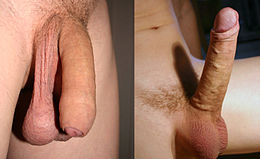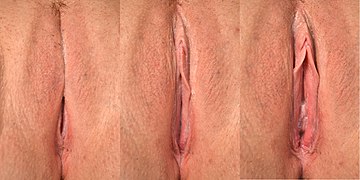erection

Under erection (from latin erectile , erection ' ) is understood to mean generally the stiffening of the penis ( penis ), which spontaneously or by mechanical or psychological stimuli, in particular by sexual arousal , takes place. The erection is caused by increasing the blood flow and throttling of the blood flow in the erectile tissue and is a prerequisite for normal sexual intercourse . The female clitoris is also capable of erecting.
physiology



The erection is normally triggered during sexual arousal through the erection center in the lower spinal cord , but it can also be brought about directly reflex by mechanical stimulation of the penis and testicles . Psychological stimuli such as erotic perceptions or ideas are primarily responsible for sexual arousal ; smell stimuli also play a major role in other animals.
The size difference between the resting state and the erect penis varies greatly from person to person and is usually between two to four times its length and one and a half to three times its diameter.
The erection of the penis is one of the prerequisites for penetration during intercourse. The erection therefore only enables the vaginal intercourse relevant to reproduction , in which the erect male member is inserted into the female vagina . A fertilization without an erection can still take place under special circumstances.
From a layman's point of view, male erectile function is often equated with general virility, potency or reproductive ability and viewed as a sign of youth and vitality. But erections can also occur in the fetus , infants and old people. In healthy people of almost any age, erections occur regularly during sleep within the so-called REM phases . If this occurs when you wake up, it is called a morning erection . Orgasms with ejaculations during sleep, pollutions , are very often, but not always, associated with erections.
Even in the dead, so-called post - mortem erections can occur, but these are due to passive blood congestion, e.g. B. due to a hanging position of the corpse.
Erection mechanism
The erection of the male member takes place by filling the corpus cavernosum with blood , especially the corpus cavernosum penis . In the erectile tissue of the penis, the tendril arteries ( arteriae helicinae ) open under the influence of the parasympathetic nerve ( Nervi pelvini , also known as Nervi erigentes ). These tributaries to the erectile tissue of the penis are blocking arteries . In addition, the smooth muscles of the erectile tissue of the penis relax .
The ischiocavernosus muscle is used to strengthen the erection in the final rigid-erection phase by exerting compressions on the base of the erectile tissue , which build up greatly increased blood pressure in the corpus cavernosum penis . This can be a multiple of the systolic blood pressure (upper blood pressure value), 400 mmHg in humans and 1000 mmHg in other mammals . In addition, through its compression work, the muscle inhibits the venous blood outflow of the corpus cavernosum penis or the corpus cavernosum clitoridis through the vena profunda penis or the vena profunda clitoridis. Identical functions of the muscle have also been demonstrated for the nocturnal erection during sleep.
During the erection of the clitoris or the penis , sensory stimuli, in addition to corresponding sensory perceptions , i.e. activation of corresponding nerve areas ( afferents to areas in the cerebrum, hypothalamus and sacral spinal cord ( parasympathetic nervous system )), activate the endothelial cells in the blood vessels the clitoris or penis play an important role. Via activation of endothelial nitric oxide synthase is the neurotransmitter nitric oxide (NO), a Gasotransmitter released in the corresponding barrel section. This nitrogen monoxide (NO) then leads to the increased formation of cyclic guanosine monophosphate (cGMP) via the activation of guanylyl cyclase . By then taking place vasodilation, the clitoral or penile erectile tissues with blood (Vaso fill congestion ).
The urethral ( corpus spongiosum penis ) and glans cavernous body ( corpus spongiosum glandis ) - in contrast to the penile cavernous body - are perfused with blood even when the patient is relaxed. During the erection, the bulbospongiosus muscle pushes the drainage through the vena bulbi penis , so that this cavernous body is also filled. This leads to an enlargement of the glans, but the stiffness of the limb is hardly affected. In addition, the blood outflow is not completely throttled here, as a second outflow remains via the dorsal penis vein , so that both cavernous bodies can still be depressed even with maximum erection. The bulbospongiosus muscle also performs rhythmic contractions shortly before the ejaculation , which, due to the second drainage path that still exists, generate pulsating erection waves and thus support the ejection of semen.
Swelling of the penis
After the sexual climax - usually with orgasm and ejaculation - or when sexual arousal declines, the erection decreases and the blood flows out of the erectile tissue. The swelling is scientifically known as detumescence and is probably due to the release of the hormones oxytocin and prolactin after an orgasm . The decongestion together with the subsequent time until the next possible orgasm is called the refractory phase . The renewed erection can be inhibited or completely blocked during this time.
Erection of female genitals
In a broader sense, the swelling of the clitoris and labia is also known as an erection. The swelling caused by the labia erection can partially open the vulva . The term lubrication is usually used for the moisturizing of the female genitals . Around the vaginal vestibule, ostium vaginae or vaginal entrance, introitus vaginae are located glands that ensure the moistening of the vagina , since the latter itself is glandless:
- Bartholin's gland ( glandula vestibularis major )
- Paraurethral gland ("prostate feminina")
- small atrial glands ( glandulae vestibulares minores )
The system of the female erectile tissue is far more extensive and not only covers the outer visible part of the clitoris or glans clitoridis .
Graphic: System of the female erectile tissue
Erection problems
Erectile dysfunction
Erectile dysfunction in men is called erectile dysfunction and can have a variety of organic and psychological causes. They affect men of all ages but become more common with age. For some years now, PDE-5 inhibitors have been available as drugs for the treatment of erectile dysfunction (e.g. sildenafil , tadalafil or vardenafil ). Alternatively, the active ingredient alprostadil is mainly used for local treatment . Depending on the type of application, a distinction is made between cavernous body autoinjection therapy (SKAT), urethral rods (MUSE) and cream drops for the urethral opening. Among other things, phallography is used diagnostically . It is used to detect nocturnal erections. A ribbon with integrated strain gauges is placed around the penis and connected to a recording device. If the cavernous bodies fill up, this is recorded and can be evaluated later by the doctor. With this method, psychogenic and physiological causes of erectile problems can be distinguished.
Priapism
A painful permanent erection of the penis that lasts more than two hours is called priapism and requires immediate treatment. It is an emergency which, without immediate urological treatment, permanently damages the penis and especially the erectile tissue. If no treatment is given, the penis can permanently lose erectile function.
Mechanism of erection in other mammals
This erection mechanism can be found in principle in all mammals , but varies depending on the type of penis. In many animals, the penile cavernous body is partially calcified to form the penis bone , so that there is only a little swelling tissue and the penis has a basic rigidity. In animals with a fibroelastic penile type (e.g. cloven-hoofed animals ), only a small amount of blood is required to fill the penile body. Here, the blood filling - supported by the relaxation of the retractor penis muscle and the inherent elasticity of the connective tissue - leads to the S-shaped bend of the penis disappearing and thus an elongation, but hardly any thickening of the penis. In dogs , the filling of the erectile penis shows a special feature. With them, the vena dorsalis penis passes under the ischiourethralis muscle , which completely prevents the blood from flowing out of the penile body after the penis has been inserted. As a result, the glans in dogs swells considerably and the males “hang” in the bitch for up to 30 minutes after ejaculation. Separation of animals at this point can lead to serious genital injuries and is animal cruelty. Insemination of the bitch can usually not be prevented by separation, as the ejaculation occurs very early.
Penile bones of a dog (arrow points to the groove for the urethra on the underside )
Erection of a
baboon
literature
- Klaus M. Beier, Hartmut AG Bosinski, Kurt Loewit; Klaus M. Beier (Ed.): Sexualmedizin. 2nd edition, Elsevier / Urban & Fischer, Munich / Jena 2005, ISBN 3-437-22850-1 .
- Ernest Bornemann : The great lexicon of sexuality. Pawlak, Herrsching 1984, ISBN 3-88199-148-4 .
- Clellan S. Ford, Frak H. Beach: The sexual behavior of humans and animals (= Patterns of sexual behavior ). Rowohlt, Reinbek 1971, ISBN 3-499-68006-8 .
- Martin Goldstein, Will McBride: Lexicon of Sexuality. 400 x information, answer and description. 2nd Edition. Jugenddienst-Verlag, Wuppertal / Barmen 1970, ISBN 3-7795-7001-7 .
- Erwin J. Haeberle : The sexuality of humans. Manual and atlas. Nikol, Hamburg 2000, ISBN 3-933203-22-8 .
- Alfred Charles Kinsey et al. a .: The sexual behavior of men (= sexual behavior in the human male ). Fischer, Frankfurt am Main 1970.
- William H. Masters, Virginia E. Johnson: The sexual response (= Human sexual response ). Rowohlt, Reinbek 1980, ISBN 3-499-17814-1 .
- Volkmar Sigusch , Gunter Schmidt : Youth sexuality. Documentation and investigation. Enke, Stuttgart 1973, ISBN 3-432-01835-5 .
- Hans Peter Duerr The myth of the civilization process. Volume 3: Obscenity and Violence. Suhrkamp, Frankfurt am Main 1993, ISBN 3-518-40488-1 .
Web links
Individual evidence
- ↑ DM Sherer, PC Eggers, JR Woods Jr .: In-utero fetal penile erection. In: Journal of Ultrasound in Medicine. (JUM), June 1990, Volume 9, No. 6, p. 371, PMID 2192091 .
- ↑ DAL Pedreira, A. Yamasaki, CE Czeresnia: Fetal phallus 'erection' interfering with the sonographic determination of fetal gender in the first trimester. In: Ultrasound in Obstetrics & Gynecology. Oct. 2001, Volume 18, No. 4, pp. 402-404, doi: 10.1046 / j.0960-7692.2001.00532.x ( full text ).
- ^ AA Jakobovits: Fetal penile erection. In: Ultrasound in Obstetrics & Gynecology . Oct. 2001, Volume 18, No. 4, p. 405, doi: 10.1046 / j.0960-7692.2001.00477.x ( full text ).
- ↑ Erwin J. Haeberle: The sexuality of man. 2nd expanded edition, de Gruyter, Berlin 1985, chapter 1.3.1 .: Early childhood. In: Magnus Hirschfeld Archive for Sexology. ( Memento from October 12, 2010 in the Internet Archive )
- ↑ Anja Lehmann: Psychosocial influencing factors on female sexual experience. Dissertation, Faculty of Education and Psychology, Free University of Berlin, Berlin 2007, p. 32: 1.3. Sexual development over the life span. → 1.3.1. Early childhood. ( Full text as PDF file ).
- ^ William E. Hartman, Marilyn A. Fithian: Human Sexuality: An Encyclopedia Ejaculation. In: Erwin J. Haeberle (Ed.): Human Sexuality: An Encyclopedia. Section E. / EJACULATION. ( Memento from October 8, 2011 in the Internet Archive )
- ^ MH Schmidt, HS Schmidt: The ischiocavernosus and bulbospongiosus muscles in mammalian penile rigidity. In: Sleep. Volume 16, Number 2, February 1993, ISSN 0161-8105 , pp. 171-183, PMID 8446838 (Review).
- ^ RC Dean, TF Lue: Physiology of penile erection and pathophysiology of erectile dysfunction. In: The Urologic clinics of North America. Volume 32, Number 4, November 2005, ISSN 0094-0143 , pp. 379-395, v, doi: 10.1016 / j.ucl.2005.08.007 , PMID 16291031 , PMC 1351051 (free full text) (review).
- ^ Hermann van Ahlen, Sabine Kliesch: Disorders of Erection, Cohabitation, and Ejaculation. In: Eberhard Nieschlag, Hermann M. Behre, Susan Nieschlag: Andrology. Male Reproductive Health and Dysfunction. Springer Science & Business Media, 2010, pp. 279-322, ISBN 3-540-78355-5 , pp. 285 f.
- ^ Gregory B. Auffenberg, Brian T. Hellfand, Kevin T. McVary: Normal Erectile Physiology. In: Kevin T. McVary: Contemporary Treatment of Erectile Dysfunction. A clinical guide. Springer Science & Business Media, 2010, 299 p., P. 11-22, ISBN 1-60327-536-3 , p. 15.
- ↑ P. Lavoisier, R. Aloui, J. IWAZ, MJ Kokkidis: The physiology of penile rigidity. In: Progrès en urologie: journal de l'Association française d'urologie et de la Société française d'urologie. Volume 2, Number 1, February 1992, ISSN 1166-7087 , pp. 119-127, PMID 1299511 (review).
- ^ P. Lavoisier, J. Proulx, F. Courtois, F. De Carufel, LG Durand: Relationship between perineal muscle contractions, penile tumescence and penile rigidity during nocturnal erections. In: The Journal of urology. Volume 139, Number 1, January 1988, ISSN 0022-5347 , pp. 176-179, PMID 3336091 .
- ↑ A. Hermann et al .: Gases as cellular signal substances. Gas transmitter. In: Biology in Our Time. 2010, No. 40, pp. 185–193 ( doi: 10.1002 / biuz.201010422 , PDF file; 1.3 MB ( memento from December 3, 2013 in the Internet Archive )).
- ↑ a b Uwe Gille: Male sexual organs. In: F.-V. Salomon et al. a. (Ed.): Anatomy for veterinary medicine. Enke, Stuttgart 2004, ISBN 3-8304-1007-7 , pp. 389-403.






